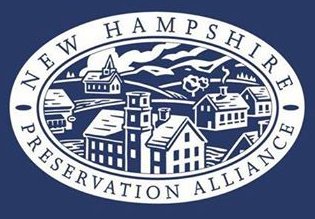Kensington Town Hall Success
The rehabilitated Kensington Town Hall reopened in September 2016 after an eight year process that featured mold problems and demolition conversation yielding to effective outreach and “win-win” rehabilitation solutions.
This simple Greek Revival building was purpose-built in 1846 exclusively for use by town government. It replaced the original meeting house on the site, reusing its massive timbers in the construction. Since that time, it has also been a primary venue for Kensington’s socials, dances and lectures. It is one of the three iconic buildings that define the center of Kensington.
During the Mother’s Day floods of 2008, ground water infiltrated the offices that were created in 1981 in the basement of the town hall, and mold was discovered growing in boxes of books and under file cabinets. Town employees became ill and the selectmen commissioned mold studies. As a result, the office spaces were gutted and rebuilt, and new offices were added in the historic stage area of the auditorium. But the mold issues persisted, and after a lawsuit was filed, the selectmen relocated the town offices and police department to other quarters. Then they considered their options for the condemned building. Gut it “to the studs” and reconfigure the office space? Demolish the “old” town hall and construct an entirely new building?
The Friends of the Kensington Town Hall came together to raise awareness of the plight of the historic building and assist with preservation options. They bartered for a report from Tim Nichols, a local engineer, to analyze the issues and offer an alternate opinion and options for preservation. At the same time they prepared a NH Division of Historical Resources (DHR) inventory form and were offered State Register listing for the Town House. When the selectmen refused to sign the letter allowing the listing, the Friends prepared a nomination for listing to the National Register of Historic Places. When that recognition was received, a bronze plaque was placed on the building. Later in 2011, the Friends advocated for and won a coveted spot for the building on the New Hampshire Preservation Alliance’s Seven to Save list.
The Friends then launched a town-wide initiative to change public opinion and bring the town hall back into productive use for the town in a safe condition at a reasonable cost to taxpayers. Strategies included a broad-based email network, a Facebook page, a postcard-writing campaign, web-based and printed information, and colorful posters, brochures and buttons. The Friends kept the public informed and kept the pressure on the selectmen with a series of articles in the local newspapers, and raised private contributions from dozens of townsfolk to fund their work.
The Friends’ challenge was to do what earlier efforts had not accomplished: determine the source of the moisture infiltration, make a plan to correct it, remediate all adverse existing conditions, and assure that the problems would not recur. They wrote a warrant article and the town voted $10,000 to remediate the mold and other conditions that had made town employees sick, campaigned for it and got it passed at the March 2012 town meeting despite vocal dissent from the selectmen. (Citizens requested and got an informal vote of approval and a standing ovation at the deliberative session!). The article passed by a large margin at the polls. In contrast, the selectmen backed a $1.5 million plan to build a new municipal complex and this was soundly defeated. When it came time for the work, however, this effort ended up costing $17,360 and the Friends found themselves short. They were saved by an emergency grant of $4,000 from the National Trust for Historic Preservation, an award that also helped strengthen their local credibility. The remainder was paid by donations from over 35 townspeople totaling $3,360.
The remediation of the mold accomplished, in 2014 they wrote another article for $52,000 to complete the repair of the Town Hall, and it passed by a large margin. Work included the installation of proper drainage and gutters, sealing the foundation, and using non-porous materials to replace some of those that were removed in the remediation process. When the work was accomplished, air-quality testing showed that the building was mold-free and completely safe for occupancy.
A new board of selectmen is now in place who are extremely supportive of the effort to return town offices and police to the town hall. They wrote an article for the 2015 warrant requesting $40,000 for the services of a preservation architect to study and design a modest addition that would house new offices for the police and town employees at the historic Town Hall. It passed by a large margin, prompting the selectmen to confidently ask the Preservation Alliance to remove the Kensington town hall from the Seven to Save list.
The Kensington Town Hall opened in September 2016 with a 2,000-square-foot addition that respects the history of the 1846 structure and allows town departments to serve residents more efficiently with fully modern capabilities and equipment. The project included correcting a problem with mold, and the Board of Selectmen did it without raising taxes and with local labor whenever possible to bring new life and usefulness to this historic town hall meetinghouse.


